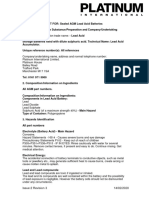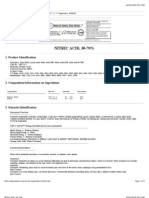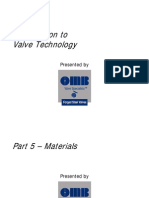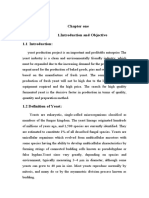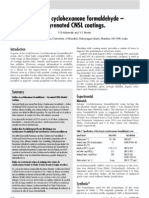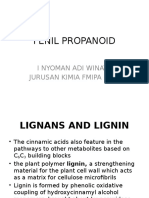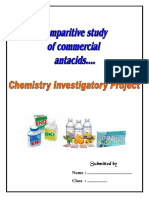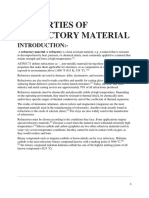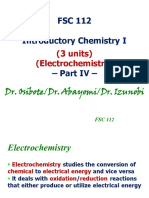NSB Opzv SDS-430-01047 151104
NSB Opzv SDS-430-01047 151104
Uploaded by
mjmardonesCopyright:
Available Formats
NSB Opzv SDS-430-01047 151104
NSB Opzv SDS-430-01047 151104
Uploaded by
mjmardonesOriginal Title
Copyright
Available Formats
Share this document
Did you find this document useful?
Is this content inappropriate?
Copyright:
Available Formats
NSB Opzv SDS-430-01047 151104
NSB Opzv SDS-430-01047 151104
Uploaded by
mjmardonesCopyright:
Available Formats
VALVE REGULATED GEL LEAD ACID BATTERIES
1. IDENTIFICATION REVISION DATE: 11-04-15
Product Name: Lead Acid Battery, Non-Spillable Product Use: Electric Storage Battery
Wet Manufacturer: Eternity Technologies Fz LLC.
PO BOX 35102
Synonyms: Industrial Battery, Traction Battery, Al Jazeera/Al Hama; Rsa Al Khaimah
Stationary Battery, Deep Cycle Battery UAE.00971-7-2433535
Supplier: NorthStar Battery, Co., LLC
Address: 4000 E. Continental Way,
Springfield, MO 65803
General Information Number: 417.575.8200 CAS Number: Not Applicable
ENERNITY 00971-7-2433535
2. GHS HAZARDS IDENTIFICATION
Health Environmental Physical
Acute Toxicity Aquatic Chronic 1 Explosive Chemical, Division 1.3
(Oral/Dermal/Inhalation) - Category 4 Aquatic Acute 1
Skin Corrosion/Irritation - Category 1A
Eye Damage - Category 1
Reproductive - Category 1A
Carcinogenicity (lead) - Category 1B
Carcinogenicity (arsenic) - Category 1A
Carcinogenicity (acid mist) - Category 1A
Specific Target Organ - Category 2
Toxicity (repeated exposure)
GHS Label:
Health Environmental Physical
Hazard Statements Precautionary Statements
DANGER! Wash thoroughly after handling.
Causes severe skin burns and eye damage. Do not eat, drink or smoke when using this product.
Causes serious eye damage. Wear protective gloves/protective clothing, eye protection/face
May damage fertility or the unborn child protection.
if ingested or inhaled. Avoid breathing dust/fume/gas/mist/vapors/spray.
May cause cancer if ingested or inhaled. Use only outdoors or in a well-ventilated area.
Causes damage to central nervous system, Causes skin irritation, serious eye damage.
blood and kidneys through prolonged or Contact with internal components may cause irritation or severe
repeated exposure. burns. Avoid contact with internal acid.
May form explosive air/gas mixture Irritating to eyes, respiratory system, and skin.
during charging.
Extremely flammable gas (hydrogen).
Explosive, fire, blast or projection hazard.
Date: 11-04-15 ECO-100788 ISO Clause: 4.3.1 DCN: SDS-430-01047-01 Page: 1 of 10
VALVE REGULATED GEL LEAD ACID BATTERIES
3. *COMPOSITION / INFORMATION ON INGREDIENTS
INGREDIENTS (Chemical/Common Names): CAS No.: % by Wt:
Inorganic Lead Compounds *Lead 7439-92-1 60
Antimony 7440-36-0 1.8
Arsenic 7440-38-2 0.2
Calcium 7440-70-2 0.2
Tin 7440-31-5 0.2
Electrolyte (sulfuric acid) 7664-93-9 10-30
JAR/LID Materials:
Styrene Acrylonitrile 9003-56-9 5-10
OTHER:
Silicon Dioxide 60676-86-0
4. FIRST AID MEASURES
INHALATION:
Sulfuric Acid: Remove to fresh air immediately. If not breathing, give artificial respiration. If breathing is
difficult, give oxygen. Consult a physician.
Lead: Remove from exposure, gargle, wash nose and lips; consult physician.
INGESTION:
Sulfuric Acid: Give large quantities of water; Do NOT induce vomiting or aspiration into the lungs may occur
and can cause permanent injury or death; consult physician.
Lead: Consult physician immediately.
SKIN:
Sulfuric Acid: Flush with large amounts of water for at least 15 minutes; remove contaminated clothing
completely, including shoes. If symptoms persist, seek medical attention. Wash contaminated clothing before
reuse. Discard contaminated shoes.
Lead: Wash immediately with soap and water.
EYES:
Sulfuric Acid and Lead: Flush immediately with large amounts of water for at least 15 minutes while lifting
lids; Seek immediate medical attention if eyes have been exposed directly to acid.
5. FIRE FIGHTING MEASURES
Flash Point: Not Applicable
Flammable Limits: LEL = 4.1% (Hydrogen Gas in air); UEL = 74.2%
Extinguishing media: CO2; foam; dry chemical. Do not use carbon dioxide directly on cells. Avoid breathing
vapors. Use appropriate media for surrounding fire.
Fire Fighting Procedures:
Use positive pressure, self-contained breathing apparatus. Beware of acid splatter during water application and
wear acid-resistant clothing, gloves, face and eye protection. If batteries are on charge, shut off power to the
charging equipment, but note that strings of series connected batteries may still pose risk of electric shock even
when charging equipment is shut down.
Date: 11-04-15 ECO-100788 ISO Clause: 4.3.1 DCN: SDS-430-01047-01 Page: 2 of 10
VALVE REGULATED GEL LEAD ACID BATTERIES
Hazardous Combustion Products:
Highly flammable hydrogen gas is generated during charging and operation of batteries. If ignited by burning
cigarette, naked flame or spark, may cause battery explosion with dispersion of casing fragments and corrosive
liquid electrolyte. Carefully follow manufacturer's instructions for installation and service. Keep away all
sources of gas ignition and do not allow metallic articles to simultaneously contact the negative and positive
terminals of a battery. Follow manufacturer's instructions for installation and service.
6: ACCIDENTAL RELEASE MEASURES
Stop flow of material, contain/absorb small spills with dry sand, earth or vermiculite. Do not use combustible
materials. If possible, carefully neutralize spilled electrolyte with soda ash, sodium bicarbonate, lime, etc. Wear
acid-resistant clothing, boots, gloves, and face shield. Do not allow discharge of un-neutralized acid to sewer.
Acid must be managed in accordance with approved local, state, and federal requirements. Consult state
environmental agency and/or federal EPA.
7. HANDLING AND STORAGE
Handling:
Unless involved in recycling operations, do not breach the casing or empty the contents of the battery. Handle
carefully and avoid tipping, which may allow electrolyte leakage. There may be increasing risk of electric shock
from strings of connected batteries. Keep containers tightly closed when not in use. If battery case is broken,
avoid contact with internal components. Keep vent caps on and cover terminals to prevent short circuits. Place
cardboard between layers of stacked automotive batteries to avoid damage and short circuits. Keep away from
combustible materials, organic chemicals, reducing substances, metals, strong oxidizers and water. Use
banding or stretch wrap to secure items for shipping.
Storage:
Store batteries under roof in cool, dry, well-ventilated areas separated from incompatible materials and from
activities that may create flames, spark, or heat. Store on smooth, impervious surfaces provided with measures
for liquid containment in the event of electrolyte spills. Keep away from metallic objects that could bridge the
terminals on a battery and create a dangerous short-circuit.
Charging:
There is a possible risk of electric shock from charging equipment and from strings of series connected
batteries, whether or not being charged. Shut-off power to chargers whenever not in use and before detachment
of any circuit connections. Batteries being charged will generate and release flammable hydrogen gas. Charging
space should be ventilated. Keep battery vent caps in position. Prohibit smoking and avoid creation of flames
and sparks nearby. Wear face and eye protection when near batteries being charged.
Date: 11-04-15 ECO-100788 ISO Clause: 4.3.1 DCN: SDS-430-01047-01 Page: 3 of 10
VALVE REGULATED GEL LEAD ACID BATTERIES
8. EXPOSURE CONTROLS / PERSONAL PROTECTION
Exposure Limits (mg/m3) Note: N.E. = Not Established
INGREDIENTS OSHA PEL ACGIH US NIOSH Quebec PEV Ontario OEL EU OEL
(Chemical/Common Names):
Lead and Lead Compounds 0.05 0.05 0.05 0.05 0.05 0.15 (b)
(inorganic)
Electrolyte (H2SO4/H2O) 1 0.2 1 1 0.2 0.05 (c)
Tin 2 2 2
(a) As dusts/mists (b) As inhalable aerosol (c) Thoracic fraction (d) Potential occupational carcinogen
(e) Based on OEL’s of Austria, Belgium, Denmark, France, Netherlands, Switzerland, & U.K.
(f) Based on OEL of Belgium (g) Based on OEL of Netherlands
Engineering Controls (Ventilation):
Store and handle in well-ventilated area. If mechanical ventilation is used, components must be acid-resistant.
Handle batteries cautiously, do not tip to avoid spills. Make certain vent caps are on securely. If battery case is
damaged, avoid bodily contact with internal components. Wear protective clothing, eye and face protection,
when filling, charging or handling batteries. Do not allow metallic materials to simultaneously contact both the
positive and negative terminals of the batteries. Charge batteries in areas with adequate ventilation. General
dilution ventilation is acceptable.
Respiratory Protection (NIOSH/MSHA approved):
None required under normal conditions. When concentrations of sulfuric acid mist are known to exceed PEL,
use NIOSH or MSHA-approved respiratory protection.
Skin Protection:
If battery case is damaged, use rubber or plastic acid-resistant gloves with elbow-length gauntlet, acid-resistant
apron, clothing and boots.
Eye Protection:
If battery case is damaged, use chemical goggles or face shield.
Other Protection:
In areas where water and sulfuric acid solutions are handled in concentrations greater than 1%, emergency
eyewash stations and showers should be provided, with unlimited water supply. Chemically impervious apron
and face shield recommended when adding water or electrolyte to batteries. Wash Hands after handling.
Date: 11-04-15 ECO-100788 ISO Clause: 4.3.1 DCN: SDS-430-01047-01 Page: 4 of 10
VALVE REGULATED GEL LEAD ACID BATTERIES
9. PHYSICAL AND CHEMICAL PROPERTIES
Properties Listed Below are for Electrolyte:
Boiling Point: 203 - 240° F
Specific Gravity (H20 = 1)
Product 1.240 to 1.270
Boiling Point: 203 – 204°F
Melting Point: N/A Vapor Pressure (mm Hg): 10
Solubility in Water: 100% Vapor Density (AIR = 1): Greater than 1
Evaporation Rate: Less than 1 % Volatile by Weight: N/A
(Butyl Acetate = 1)
pH: ~1 to 2 Flash Point: Below room temperature
(as hydrogen gas)
LEL (Lower Explosive 4% UEL (Upper Explosive Limit) 74% (Hydrogen)
Limit) (Hydrogen)
Appearance and Odor: Manufactured article; no apparent odor. Electrolyte is a clear liquid with a
sharp, penetrating, pungent odor.
10. STABILITY AND REACTIVITY
Stability: Stable X Unstable __
This product is stable under normal conditions at ambient temperature.
Conditions to Avoid: Prolonged overcharge at high current; sources of ignition.
Incompatibilities: (materials to avoid)
Electrolyte: Contact with combustibles and organic materials may cause fire and explosion. Also reacts
violently with strong reducing agents, metals, sulfur trioxide gas, strong oxidizers, and water. Contact with
metals may produce toxic sulfur dioxide fumes and may release flammable hydrogen gas.
Lead compounds: Avoid contact with strong acids, bases, halides, halogenates, potassium nitrate,
permanganate, peroxides, nascent hydrogen, and reducing agents.
Hazardous Decomposition Products:
Electrolyte: Sulfur trioxide, carbon monoxide, sulfuric acid mist, sulfur dioxide, hydrogen sulfide.
Lead compounds: Temperatures above the melting point are likely to produce toxic metal fume, vapor, or dust;
contact with strong acid or base or presence of nascent hydrogen may generate highly toxic arsine gas.
Hazardous Polymerization:
Will not occur
Date: 11-04-15 ECO-100788 ISO Clause: 4.3.1 DCN: SDS-430-01047-01 Page: 5 of 10
VALVE REGULATED GEL LEAD ACID BATTERIES
11. TOXICOLOGICAL INFORMATION
Routes of Entry:
Sulfuric Acid: Harmful by all routes of entry.
Lead Compounds: Hazardous exposure can occur only when product is heated, oxidized or otherwise processed
or damaged to create dust, vapor or fume. The presence of nascent hydrogen may generate highly toxic arsine
gas.
Inhalation:
Sulfuric Acid: Breathing of sulfuric acid vapors or mists may cause severe respiratory irritation.
Lead Compounds: Inhalation of lead dust or fumes may cause irritation of upper respiratory tract and lungs.
Ingestion:
Sulfuric Acid: May cause severe irritation of mouth, throat, esophagus and stomach.
Lead Compounds: Acute ingestion may cause abdominal pain, nausea, vomiting, diarrhea and severe cramping.
This may lead rapidly to systemic toxicity and must be treated by a physician.
Skin Contact:
Sulfuric Acid: Severe irritation, burns and ulceration.
Lead Compounds: Not absorbed through the skin.
Eye Contact:
Sulfuric Acid: Severe irritation, burns, cornea damage, and blindness.
Lead Compounds: May cause eye irritation.
Effects of Overexposure - Acute:
Sulfuric Acid: Severe skin irritation, damage to cornea, upper respiratory irritation.
Lead Compounds: Symptoms of toxicity include headache, fatigue, abdominal pain, loss of appetite, muscular
aches and weakness, sleep disturbances and irritability.
Effects of Overexposure - Chronic:
Sulfuric Acid: Possible erosion of tooth enamel, inflammation of nose, throat & bronchial tubes.
Lead Compounds: Anemia; neuropathy, particularly of the motor nerves, with wrist drop; kidney damage;
reproductive changes in males and females. Repeated exposure to lead and lead compounds in the workplace
may result in nervous system toxicity. Some toxicologists report abnormal conduction velocities in persons with
blood lead levels of 50 μg/100 ml or higher. Heavy lead exposure may result in central nervous system damage,
encephalopathy and damage to the blood-forming (hematopoietic) tissues.
Date: 11-04-15 ECO-100788 ISO Clause: 4.3.1 DCN: SDS-430-01047-01 Page: 6 of 10
VALVE REGULATED GEL LEAD ACID BATTERIES
Carcinogenicity:
Sulfuric Acid: The International Agency for Research on Cancer (IARC) has classified "strong inorganic acid
mist containing sulfuric acid" as a Category I carcinogen, a substance that is carcinogenic to humans. This
classification does not apply to liquid forms of sulfuric acid or sulfuric acid solutions contained within a battery.
Inorganic acid mist (sulfuric acid mist) is not generated under normal use of this product. Misuse of the product,
such as overcharging, may result in the generation of sulfuric acid mist.
Lead Compounds: Lead is listed as a 2B carcinogen, likely in animals at extreme doses. Proof of
carcinogenicity in humans is lacking at present.
Medical Conditions Generally Aggravated by Exposure:
Overexposure to sulfuric acid mist may cause lung damage and aggravate pulmonary conditions. Contact of
sulfuric acid with skin may aggravate diseases such as eczema and contact dermatitis. Lead and its compounds
can aggravate some forms of kidney, liver and neurologic diseases.
Acute Toxicity:
Inhalation LD50:
Electrolyte: LC50 rat: 375 mg/m3; LC50: guinea pig: 510 mg/m3
Elemental Lead: Acute Toxicity Point Estimate = 4500 ppmV (based on lead bullion)
Oral LD50:
Electrolyte: rat: 2140 mg/kg
Elemental lead: Acute Toxicity Estimate (ATE) = 500 mg/kg body weight (based on lead bullion)
Additional Health Data:
All heavy metals, including the hazardous ingredients in this product, are taken into the body primarily by
inhalation and ingestion. Most inhalation problems can be avoided by adequate precautions such as ventilation
and respiratory protection covered in Section 8. Follow good personal hygiene to avoid inhalation and
ingestion: wash hands, face, neck and arms thoroughly before eating, smoking or leaving the work site. Keep
contaminated clothing out of non-contaminated areas, or wear cover clothing when in such areas. Restrict the
use and presence of food, tobacco and cosmetics to non-contaminated areas. Work clothes and work equipment
used in contaminated areas must remain in designated areas and never taken home or laundered with personal
non-contaminated clothing. This product is intended for industrial use only and should be isolated from
children and their environment.
The 19th Amendment to EC Directive 67/548/EEC classified lead compounds, but not lead in metal form, as
possibly toxic to reproduction. Risk phrase 61: May cause harm to the unborn child, applies to lead compounds,
especially soluble forms.
Date: 11-04-15 ECO-100788 ISO Clause: 4.3.1 DCN: SDS-430-01047-01 Page: 7 of 10
VALVE REGULATED GEL LEAD ACID BATTERIES
12. ECOLOGICAL INFORMATION
Environmental Fate: lead is very persistent in soil and sediments. No data on environmental degradation.
Mobility of metallic lead between ecological compartments is slow. Bioaccumulation of lead occurs in aquatic
and terrestrial animals and plants but little bioaccumulation occurs through the food chain. Most studies include
lead compounds and not elemental lead.
Environmental Toxicity: Aquatic Toxicity:
Sulfuric acid: 24-hr LC50, freshwater fish (Brachydanio rerio): 82 mg/L
96 hr- LOEC, freshwater fish (Cyprinus carpio): 22 mg/L
Lead: 48 hr LC50 (modeled for aquatic invertebrates): <1 mg/L, based on lead bullion
Additional Information
· No known effects on stratospheric ozone depletion.
· Volatile organic compounds: 0% (by Volume)
· Water Endangering Class (WGK): NA
13. DISPOSAL CONSIDERATIONS (UNITED STATES)
Spent batteries: Send to secondary lead smelter for recycling. Spent lead-acid batteries are not regulated as
hazardous waste when the requirements of 40 CFR Section 266.80 are met. Spilled sulfuric acid is a
characteristic hazardous waste; EPA hazardous waste number D002 (corrosivity) and D008 (lead).
Electrolyte: Place neutralized slurry into sealed acid resistant containers and dispose of as hazardous waste, as
applicable. Large water diluted spills, after neutralization and testing, should be managed in accordance with
approved local, state, and federal requirements. Consult state environmental agency and/or federal EPA.
Following local, State/Provincial, and Federal/National regulations applicable to end-of-life characteristics will
be the responsibility of the end-user.
14. TRANSPORT INFORMATION
U.S.DOT – (Land Transport):
Excepted from the hazardous materials regulations (HMR) because the batteries meet the
requirements of 49 CFR 173.159(f) and 49 CFR 173.159a of the U.S. Department of
Transportation’s HMR. Battery and outer package must be marked “NONSPILLABLE” or
“NONSPILLABLE BATTERY”. Battery terminals must be protected against short circuits.
IATA Dangerous Goods Regulations DGR (Air Transport):
Excepted from the dangerous goods regulations because the batteries meet the requirement of
Packing Instruction 872 and Special Provisions A67 of the International Air Transportation
Association (IATA) Dangerous goods Regulations and International Civil Aviation Organization
(ICAO) Technical Instruction. Battery Terminals must be protected against short circuits.
The words “NOT RESTRICTED”, “SPECIAL PROVISION A67” must be provided when the air
waybill is issued.
Date: 11-04-15 ECO-100788 ISO Clause: 4.3.1 DCN: SDS-430-01047-01 Page: 8 of 10
VALVE REGULATED GEL LEAD ACID BATTERIES
IMDG (Sea Transport):
Excepted from the dangerous goods regulations for transport by sea because the batteries meet the
requirements of Special Provision 238 of the International Maritime Dangerous Goods (IMDG
CODE). Battery terminals must be protected against short circuits.
15. REGULATORY INFORMATION
UNITED STATES:
EPA SARA Title III:
Section 302 EPCRA Extremely Hazardous Substances (EHS):
Sulfuric acid is a listed "Extremely Hazardous Substance" under EPCRA, with a Threshold Planning Quantity
(TPQ) of 1,000 lbs. EPCRA Section 302 notification is required if 500 lbs or more of sulfuric acid is present at
one site (40 CFR 370.10). For more information consult 40 CFR Part 355.
Section 304 CERCLA Hazardous Substances:
Reportable Quantity (RQ) for spilled 100% sulfuric acid under CERCLA (Superfund) and EPCRA (Emergency
Planning and Community Right to Know Act) is 1,000 lbs. State and local reportable quantities for spilled
sulfuric acid may vary.
Section 311/312 Hazard Categorization:
EPCRA Section 312 Tier Two reporting is required for non-automotive batteries if sulfuric acid is present in
quantities of 500 lbs or more and/or if lead is present in quantities of 10,000 lbs or more. For more information
consult 40 CFR 370.10 and 40 CFR 370.40
Section 313 EPCRA Toxic Substances: 40 CFR section 372.38 (b) states: If a toxic chemical is present in an
article at a covered facility, a person is not required to consider the quantity of the toxic chemical present in
such article when determining whether an applicable threshold has been met under § 372.25, § 372.27, or §
372.28 or determining the amount of release to be reported under § 372.30. This exemption applies whether the
person received the article from another person or the person produced the article. However, this exemption
applies only to the quantity of the toxic chemical present in the article.
Supplier Notification: This product contains toxic chemicals that may be reportable under EPCRA Section 313
Toxic Chemical Release Inventory (Form R) requirements. For a manufacturing facility under SIC codes 20
through 39, the following information is provided to enable you to complete the required reports:
Toxic Chemical CAS Number Approximate % by Weight
Lead 7439-92-1 60
Sulfuric Acid 7664-93-9 10-30
Antimony 7440-36-0 1.8
Arsenic 7440-38-2 0.2
See 40 CFR Part 370 for more details.
Date: 11-04-15 ECO-100788 ISO Clause: 4.3.1 DCN: SDS-430-01047-01 Page: 9 of 10
VALVE REGULATED GEL LEAD ACID BATTERIES
TSCA:
TSCA Section 8b – Inventory Status: All chemicals comprising this product are either exempt or listed on the
TSCA Inventory.
TSCA Section 12b (40 CFR Part 707.60(b)) No notice of export will be required for articles, except PCB
articles, unless the Agency so requires in the context of individual section 5, 6, or 7 actions.
TSCA Section 13 (40 CFR Part 707.20): No import certification required (EPA 305-B-99-001, June 1999,
Introduction to the Chemical Import Requirements of the Toxic Substances Control Act, Section IV.A)
RCRA: Spent Lead Acid Batteries are subject to streamlined handling requirements when managed in
compliance with 40 CFR section 266.80 or 40 CFR part 273. Waste sulfuric acid is a characteristic hazardous
waste; EPA hazardous waste number D002 (corrosivity) and D008 (lead).
STATE REGULATIONS (US):
STATE REGULATIONS (US):
*Proposition 65 Warning
Battery posts, terminals and related accessories contain lead and lead compounds, chemicals known to
the state of California to cause cancer and reproductive harm. Wash hands after handling.
*Battery companies not party to the 1999 consent judgment with Mateel Environmental Justice Foundation
should include a Proposition 65 Warning that complies with the current version of Proposition 65.
INTERNATIONAL REGULATIONS:
Distribution into Quebec to follow Canadian Controlled Product Regulations (CPR) 24(1) and 24(2).
Distribution into the EU to follow applicable Directives to the Use, Import/Export of the product as-sold.
16. OTHER INFORMATION
NFPA Hazard Rating for sulfuric acid:
Flammability (Red) = 0
Health (Blue) = 3
Reactivity (Yellow) = 2
Sulfuric acid is water-reactive if concentrated.
Date: 11-04-15 ECO-100788 ISO Clause: 4.3.1 DCN: SDS-430-01047-01 Page: 10 of 10
You might also like
- MSDS 25072052987561Document5 pagesMSDS 25072052987561Srinu Degala100% (1)
- 2024超威MSDS (6-DZF-12) (2024-03-21 04 - 35 - 14)Document4 pages2024超威MSDS (6-DZF-12) (2024-03-21 04 - 35 - 14)Dieudonne CoulibalyNo ratings yet
- Alkaline Battery-Panasonic - MSDSDocument6 pagesAlkaline Battery-Panasonic - MSDSISPNo ratings yet
- MSDS - Chilwee Battery - Scooter 500WDocument4 pagesMSDS - Chilwee Battery - Scooter 500WTatiana DemNo ratings yet
- Particulate and Gaseous Emissions From The Combustion of Charcoal in Barbecue GrillsDocument11 pagesParticulate and Gaseous Emissions From The Combustion of Charcoal in Barbecue GrillsPaulo FragaNo ratings yet
- C&D MSDSDocument10 pagesC&D MSDSDhiraj KapoorNo ratings yet
- MSEndurII MSDSDocument11 pagesMSEndurII MSDSFenner Tovar RojasNo ratings yet
- Ad0422 Hoja de Seguridad Bateria Just 65ahDocument10 pagesAd0422 Hoja de Seguridad Bateria Just 65ahmarcelo_29789183No ratings yet
- Safety Data Sheet: 1. IdentificationDocument10 pagesSafety Data Sheet: 1. IdentificationDaniel AndradeNo ratings yet
- OPTIMA Battery SDSDocument10 pagesOPTIMA Battery SDSDileep DileepNo ratings yet
- air accu NSB northstar_sdsDocument6 pagesair accu NSB northstar_sdsPanaran StationNo ratings yet
- Lead Acid BatteryDocument11 pagesLead Acid BatteryBheki TshimedziNo ratings yet
- Safety Data Sheet Non-Spillable Lead-Acid BatteryDocument6 pagesSafety Data Sheet Non-Spillable Lead-Acid BatteryAdam aa bbNo ratings yet
- Exide Sprinter Marathon MSDSDocument5 pagesExide Sprinter Marathon MSDSdebabratasaha.indiaNo ratings yet
- Dry BatteriesDocument7 pagesDry BatteriesWirawan Adi Setya RNo ratings yet
- Battery SDS Rev-Oct-2019Document6 pagesBattery SDS Rev-Oct-2019LEARNING POWERNo ratings yet
- MSDS - Yuasa Battery DryDocument6 pagesMSDS - Yuasa Battery DryBatanNo ratings yet
- Safety Data Sheet: Non-Spillable, Lead-Acid BatteryDocument7 pagesSafety Data Sheet: Non-Spillable, Lead-Acid BatteryOperations Admin100% (1)
- Safety Data Sheet: Revised: AEDocument7 pagesSafety Data Sheet: Revised: AERoberto VargasNo ratings yet
- Material-Safety-Data-Sheet-VRLA-Battery-EN - PDF 2Document3 pagesMaterial-Safety-Data-Sheet-VRLA-Battery-EN - PDF 2restu.krisnantoNo ratings yet
- MSDS WetLeadAcidDocument3 pagesMSDS WetLeadAcidBatanNo ratings yet
- Battery MSDSDocument3 pagesBattery MSDSEdwin GallegosNo ratings yet
- Z99 SDS EVBCHMP5000 2012 09 Safety DatasheetDocument7 pagesZ99 SDS EVBCHMP5000 2012 09 Safety DatasheetJorge MonteiroNo ratings yet
- Msds LeadDocument7 pagesMsds LeadUsman AhmedNo ratings yet
- Platinum AGM Automotive Battery MSDS - 14-02-2020Document6 pagesPlatinum AGM Automotive Battery MSDS - 14-02-2020SachinNo ratings yet
- MSDS - Yuasa Battery WetDocument9 pagesMSDS - Yuasa Battery WetBatanNo ratings yet
- Batterie Promotive Super Heavy Duty 12 V 225 Ah 1150 A VartaDocument8 pagesBatterie Promotive Super Heavy Duty 12 V 225 Ah 1150 A VartaJerome AndreNo ratings yet
- Deka Msds 49 CFR 173.159aDocument8 pagesDeka Msds 49 CFR 173.159aomer siddigNo ratings yet
- MSDS Baterias Sonnenschein A 600Document6 pagesMSDS Baterias Sonnenschein A 600Kingefrain Yusuke AmamiyaNo ratings yet
- Safety Data Sheet: Lead-Acid Battery, Wet Electrolyte (Sulfuric Acid)Document7 pagesSafety Data Sheet: Lead-Acid Battery, Wet Electrolyte (Sulfuric Acid)Nhut Nguyen100% (1)
- Safety Data SheetDocument7 pagesSafety Data SheetGermanYPNo ratings yet
- 2UCD807006-Q - CSB Battery Co., Ltd. - Material Safety Data SheetDocument7 pages2UCD807006-Q - CSB Battery Co., Ltd. - Material Safety Data SheetommirandajNo ratings yet
- CD Msds For Ups SeriesDocument4 pagesCD Msds For Ups Seriesapi-170472102No ratings yet
- Material Safety Datasheet CSB BatteriesDocument7 pagesMaterial Safety Datasheet CSB BatteriesommirandajNo ratings yet
- MQ500 Battery Safety SheetDocument4 pagesMQ500 Battery Safety SheetViktorija GaradauskieneNo ratings yet
- Lead Acid Battery Wet, Filled With Acid: Material Safety Data SheetDocument9 pagesLead Acid Battery Wet, Filled With Acid: Material Safety Data SheetDarzya OllongNo ratings yet
- Lead Acid Automotive BatteryDocument7 pagesLead Acid Automotive BatteryjfingenieroNo ratings yet
- Exide GNB Vrla Safe HandlingDocument7 pagesExide GNB Vrla Safe HandlingAsad NizamNo ratings yet
- MSDS BATRAI PDFDocument8 pagesMSDS BATRAI PDFUsmanHariantoNo ratings yet
- Material Safety Data Sheet For Boss Zinc Galvanised Paint - 400Ml - 84636052Document5 pagesMaterial Safety Data Sheet For Boss Zinc Galvanised Paint - 400Ml - 84636052ojoladapoNo ratings yet
- Asahi Cored Lead Free Solder WireDocument4 pagesAsahi Cored Lead Free Solder WireIrsyad IlhamiNo ratings yet
- MSDS - Nitric AcidDocument5 pagesMSDS - Nitric AcidFkr JabarNo ratings yet
- 13S4P-ICR ICR18650 Lithium-Ion 48VDocument8 pages13S4P-ICR ICR18650 Lithium-Ion 48Vjoe ZNo ratings yet
- Battery DryDocument4 pagesBattery DryBatanNo ratings yet
- Safety Data Sheet: 1. IdentificationDocument10 pagesSafety Data Sheet: 1. Identificationkrishnadas kotaNo ratings yet
- Safety Data Sheet: 1. IdentificationDocument10 pagesSafety Data Sheet: 1. IdentificationWajahat Aziz MarwatNo ratings yet
- Chemical Product and Company IdentificationDocument8 pagesChemical Product and Company IdentificationLeonard Fidelcristo SupitNo ratings yet
- Vrla Safety Data Sheet enDocument8 pagesVrla Safety Data Sheet enMauricio Fernando Soria UReñaNo ratings yet
- Mic 5005Document6 pagesMic 5005Marco Cornelio OrtegaNo ratings yet
- PBQ MSDS 2021 01 29Document4 pagesPBQ MSDS 2021 01 29Syed AhmedNo ratings yet
- Exide Absolyte IIP Champion Element MSDS PDFDocument5 pagesExide Absolyte IIP Champion Element MSDS PDFsistemsem30No ratings yet
- MSDS Rev 1Document8 pagesMSDS Rev 1BatanNo ratings yet
- Safety Data Sheet: Section 1. IdentificationDocument33 pagesSafety Data Sheet: Section 1. IdentificationNikolayNo ratings yet
- SDS 853027 Version AG Hawker Odyssey AGM BatteriesDocument6 pagesSDS 853027 Version AG Hawker Odyssey AGM BatteriesKader IbrahimNo ratings yet
- MSDS Battery CATDocument8 pagesMSDS Battery CATEko Dodi SetiawanNo ratings yet
- Material Safety Data Sheet: Appearance and Odor: ElectrolyteDocument5 pagesMaterial Safety Data Sheet: Appearance and Odor: Electrolytemfadil1234No ratings yet
- MSDS BatreiDocument9 pagesMSDS BatreiMuhamad HasbiNo ratings yet
- 172 4Document9 pages172 4Andini Nur PaujiahNo ratings yet
- Safety Data Sheet: 1. IdentificationDocument10 pagesSafety Data Sheet: 1. IdentificationKidry RobleroNo ratings yet
- Ritar Msds Gel PDFDocument8 pagesRitar Msds Gel PDFHanks EpphNo ratings yet
- NSB OPzV App ManualDocument8 pagesNSB OPzV App ManualmjmardonesNo ratings yet
- Ac - DC Converter ManualDocument16 pagesAc - DC Converter ManualmjmardonesNo ratings yet
- Contacts: Northstar Solar Opzv BatteriesDocument2 pagesContacts: Northstar Solar Opzv BatteriesmjmardonesNo ratings yet
- Enatel Modular Inverter System V1 - 1Document49 pagesEnatel Modular Inverter System V1 - 1mjmardonesNo ratings yet
- 00a. High Sulfidation Epithermal Deposits - CookeDocument20 pages00a. High Sulfidation Epithermal Deposits - CookePatricio Castillo ManquecoyNo ratings yet
- Chemo EXAM BANKDocument9 pagesChemo EXAM BANKlenlucy13frNo ratings yet
- OMB Valve TechDocument24 pagesOMB Valve TechUNIISCRIBDNo ratings yet
- Chemistry IaDocument4 pagesChemistry IahariniNo ratings yet
- Chemistry Chapter 2Document160 pagesChemistry Chapter 2Deepak vishalNo ratings yet
- Hsslive-xii-Chemistry-Most Important Questions and AnswersDocument30 pagesHsslive-xii-Chemistry-Most Important Questions and Answersharilalchellapan1524No ratings yet
- GOC-II TH E Ijdx1LjDocument11 pagesGOC-II TH E Ijdx1LjshashwatNo ratings yet
- Angstrom Liquid SilverDocument2 pagesAngstrom Liquid Silvertheshoeplace2No ratings yet
- Sample PaperDocument22 pagesSample PaperBindu M PillaiNo ratings yet
- Microtechnique: Dr. Esam Qnais Hashemite UniversityDocument14 pagesMicrotechnique: Dr. Esam Qnais Hashemite UniversityEnas Ahmad100% (1)
- Final Project of Baker YeastDocument27 pagesFinal Project of Baker YeastTeena Alawad100% (1)
- Studies On Cyclohexanone FormaldehydeDocument5 pagesStudies On Cyclohexanone FormaldehydeNanasaheb PatilNo ratings yet
- Bioreactor-Definition, Design, Principle, Parts, Types, Applications, LimitationsDocument14 pagesBioreactor-Definition, Design, Principle, Parts, Types, Applications, LimitationsShahriar ShamimNo ratings yet
- Fenil PropanoidDocument14 pagesFenil PropanoidRany Feby SyafitriNo ratings yet
- Methodology and Proximate AnalysisDocument46 pagesMethodology and Proximate Analysisvijaynarote67% (3)
- Sulphur CycleDocument5 pagesSulphur CycleNurul SyazwanieeNo ratings yet
- 01 Factsheet TT Testex en v01Document3 pages01 Factsheet TT Testex en v01gandhiNo ratings yet
- Adsorção Com HDL Adsorver Vermelho Do CongoDocument6 pagesAdsorção Com HDL Adsorver Vermelho Do CongoLucas Ferreira LozNo ratings yet
- Acid-Based Geopolymers: Understanding of The Structural Evolutions During Consolidation and After Thermal TreatmentsDocument8 pagesAcid-Based Geopolymers: Understanding of The Structural Evolutions During Consolidation and After Thermal TreatmentsFernando GuimaraesNo ratings yet
- 1000 SeriesDocument1 page1000 SeriesChania BhatiaNo ratings yet
- Solvent Transport Through Oil Palm Fibre Filled Low Density Polyethylene CompositesDocument11 pagesSolvent Transport Through Oil Palm Fibre Filled Low Density Polyethylene CompositesIheoma Chukwujike NwuzorNo ratings yet
- CEM1008F Applied Solution Chemistry Part 1 2021Document29 pagesCEM1008F Applied Solution Chemistry Part 1 2021Simlindile NgobelaNo ratings yet
- Anatomy and Physiology With Integrated Study Guide 5th Edition Gunstream Solution ManualDocument7 pagesAnatomy and Physiology With Integrated Study Guide 5th Edition Gunstream Solution Manualelizabeth100% (40)
- Comparitive Study of Commercial Antacids - 1Document12 pagesComparitive Study of Commercial Antacids - 1Hemant ChopraNo ratings yet
- Environmental Chemistry and AnalysisDocument12 pagesEnvironmental Chemistry and Analysissubhajit29in100% (1)
- Properties of Refractory Material: IntroductionDocument13 pagesProperties of Refractory Material: Introductionpratiksha nagargojeNo ratings yet
- Gelatin Direct CompressionDocument4 pagesGelatin Direct CompressionYuuki93No ratings yet
- Atomic Structure 3 QPDocument10 pagesAtomic Structure 3 QPkhalil rehmanNo ratings yet
- ElectrochemistryDocument35 pagesElectrochemistryOlajuwonNo ratings yet

























